Zelkova serrata
Personally, I’m a big fan of serration.
Whether it’s a megalodon tooth, a trusty pocket knife, or the foliage of a Japanese zelkova, there’s something about a jagged edge that really ups the coolness factor of various items, at least for me.

We link to vendors to help you find relevant products. If you buy from one of our links, we may earn a commission.
But in my opinion, a tree like Zelkova serrata is already quite stacked in the coolness department, even sans serration.
A beautiful vase-like form, amazingly dense foliage, and versatility in where it can be planted make for a rock star tree.
Plus, Japanese zelkova is super durable. Drought, wind, urban pollution – none of these pose much of a threat.
Such a powerful planting needs a knowledgeable gardener to grow and care for it properly. And with this guide, you’ll be giving your know-how a major upgrade.
Here’s what we’ll be getting into:
What You’ll Learn
What Is Japanese Zelkova?
Aka Zelkova serrata or the keaki tree, Japanese zelkova is a tough, densely-growing, and adaptable deciduous tree from the Zelkova genus, which contains five other species of deciduous trees and shrubs.
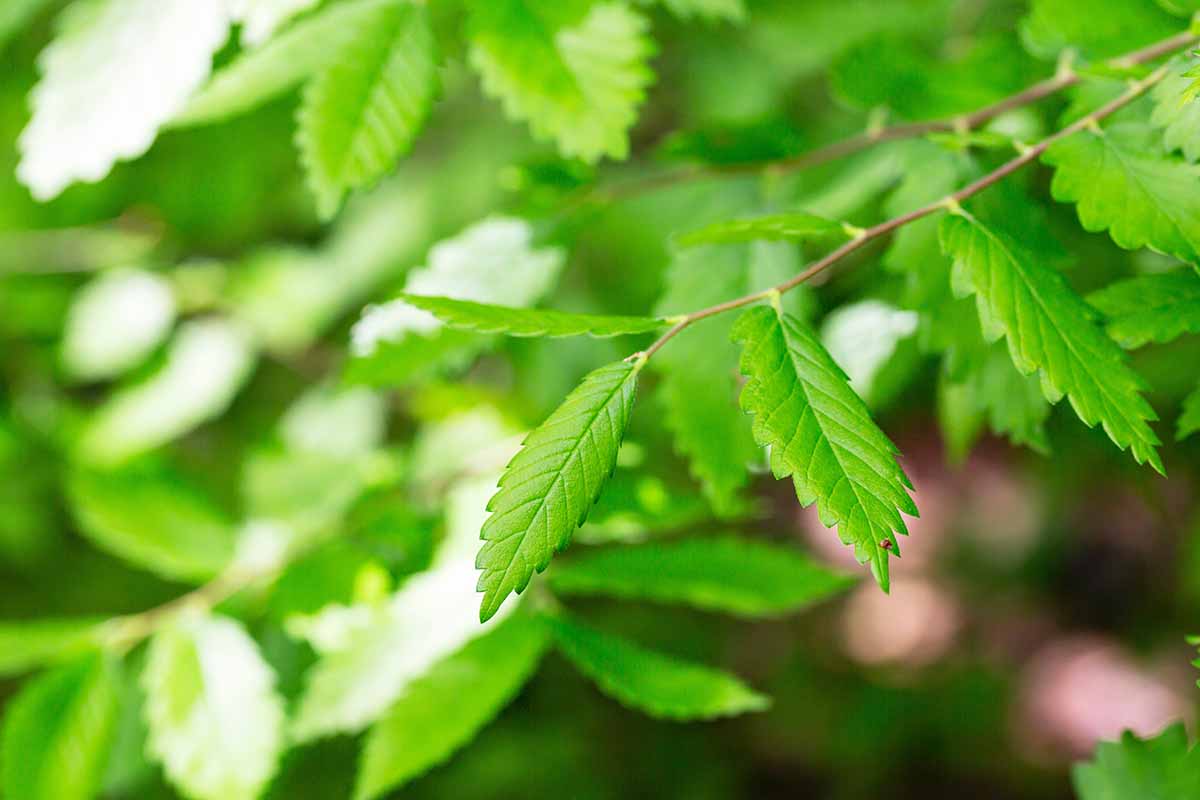
This member of the Ulmaceae or elm family is hardy in USDA Zones 5 through 8, and hails from parts of East Asia including Japan, eastern China, and Korea.
Within these environments, the tree is often found growing along the banks of waterways and at the base of mountains.
Typically reaching heights of 50 to 80 feet with a slightly narrower spread, Z. serrata flaunts a striking, upright, and vase-shaped growth habit alongside smooth, gray, stunning bark that exfoliates with age to reveal reddish-brown bark below.
The tree has a fairly vigorous growth rate, about 13 to 24 inches per year!
Zelkova actually comes from the word dzelkva, which is Georgian for “stone pillar.” This refers to the hard, strong wood of Zelkova species, which is fit for use in construction. The species name serrata is a nod to the small, toothed leaf margins.

Speaking of, Japanese zelkova leaves are dark green, serrated, and oval-shaped, with tapered tips and a length of up to five inches.
Come fall, the foliage color will change to shades of yellow, orange, or even reddish-brown.
Although green flowers do form on the tree in spring, they are insignificant enough to hardly contribute to the aesthetic.
The blooms give way to small, nut-like drupes in autumn, which don’t add much to the tree’s ornamental value either. But with a form and foliage like Z. serrata has, who needs flowers and fruits?
Cultivation and History
Since ancient times – long before they made their way to the States – Japanese zelkova trees have served as sacred, shade-providing pavilion trees at the centers of Korean villages.
Throughout Korean history, these trees have been sites of gathering, bestowing sacrifices, performing rituals, mobilizing armies, and praying.
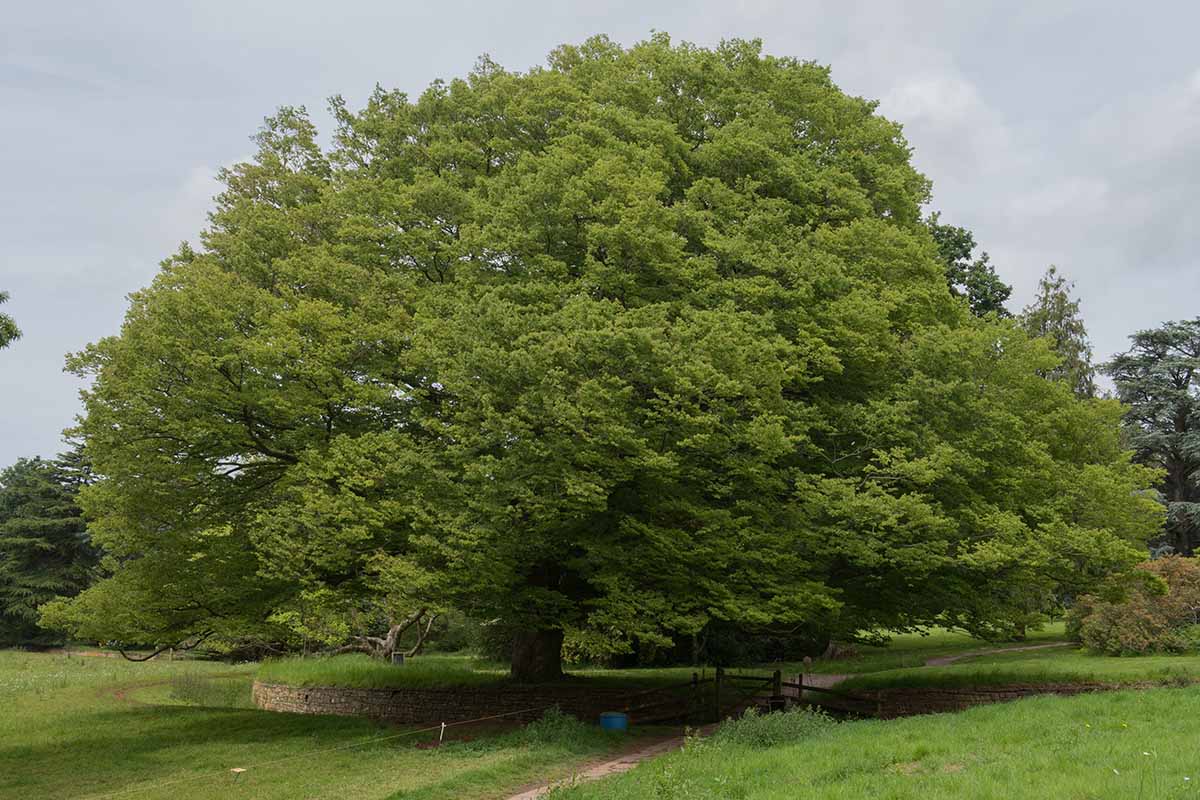
Select specimens of Japanese zelkovas in Korea are over a millennium old, and protected by Korean law as national monuments.
So revered are these monuments that in 2013, the Korea Forest Research Institute announced an initiative to clone significant Z. serrata specimens to preserve their lineage in the face of potential natural disasters and climate change.
The wood of the keyaki tree is regarded as strong, durable, attractive, and workable.
It is highly valued in Japanese commercial timber production, the construction of buildings and premium furniture, and interior decorating.
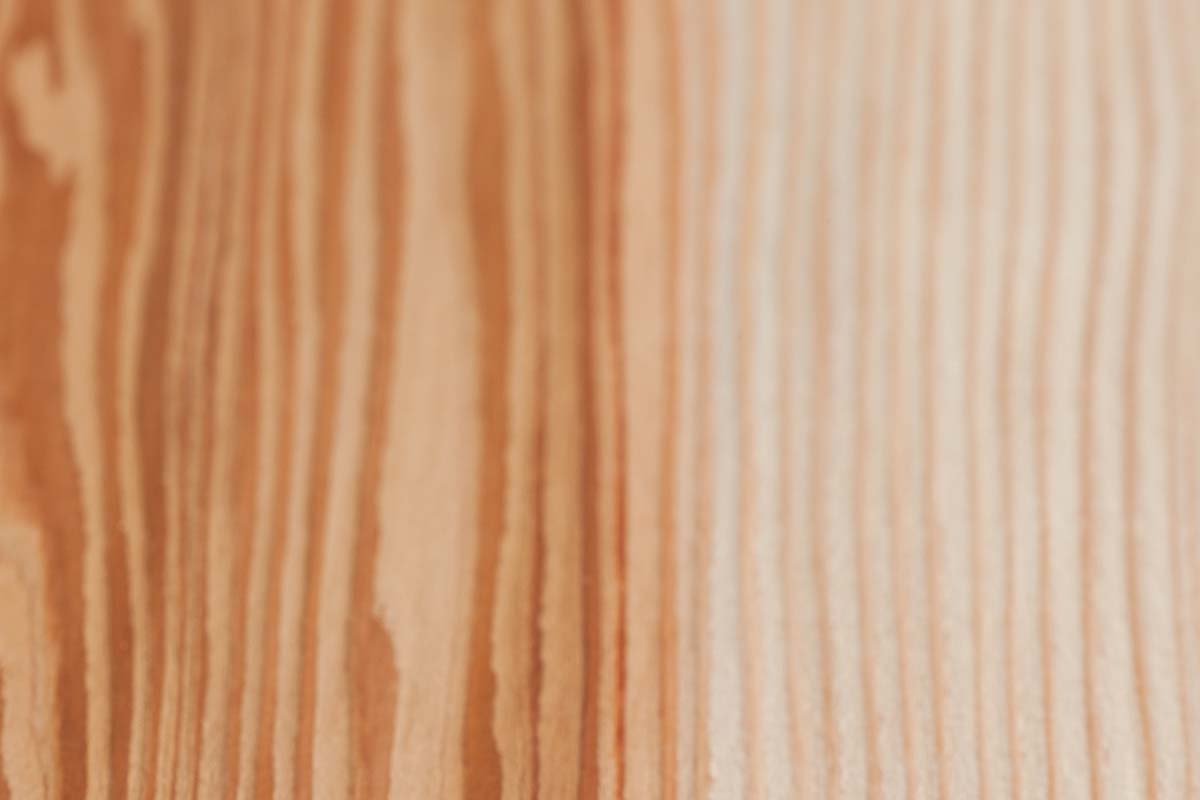
As for how Z. serrata arrived in America? Just like “It’s a Wonderful Life,” this tale begins with a young go-getter named George.
After graduating from Harvard Medical School in 1846, Dr. George Rogers Hall set sail for China, started a hospital in Shanghai, and later gave up his practice to become a trader.
This was a lucrative choice, as Dr. Hall brought valuable Asian curios, materials, and works back to America for selling.
Along with non-botanical valuables, Dr. Hall also brought many Japanese plant specimens back to the US, such as Kousa dogwoods, Japanese maples, and even Japanese honeysuckle.
In 1862, one shipment contained Japanese zelkova, and the rest is history.
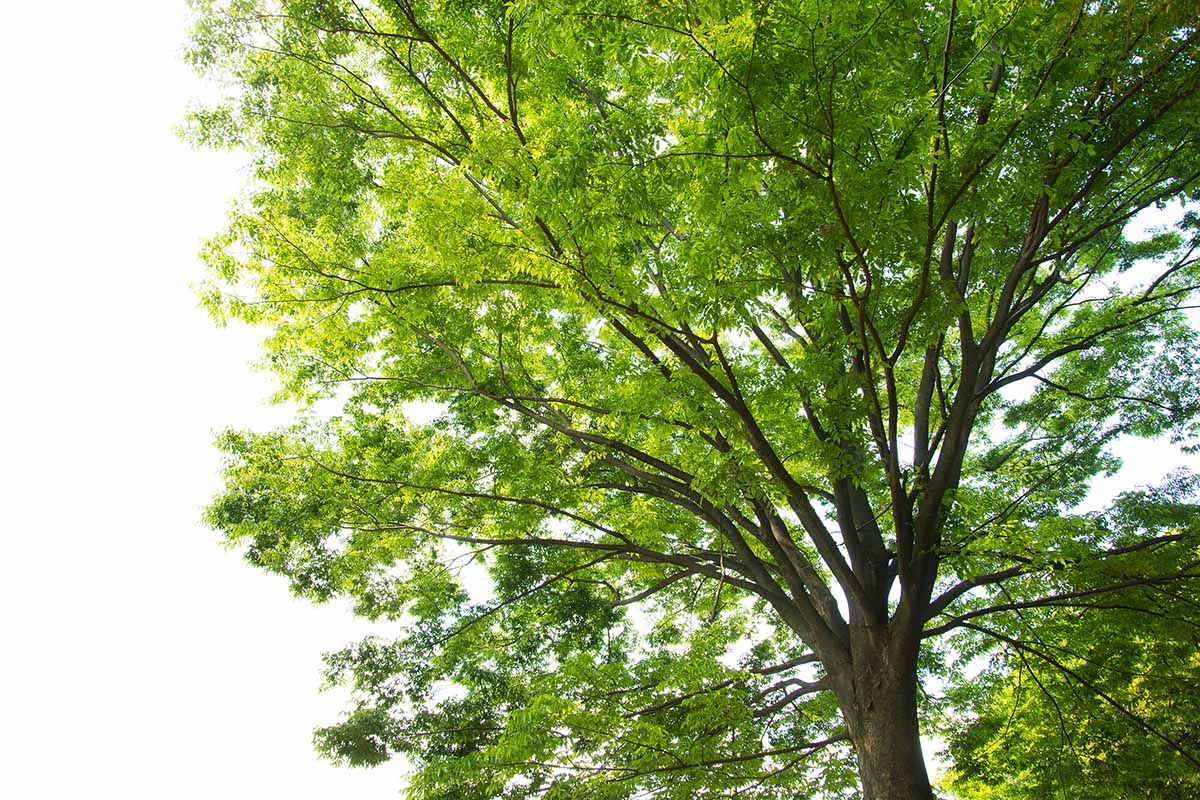
In the landscape, Japanese zelkova trees are valued for their shade, toughness, and aesthetics – so much so that the Royal Horticultural Society bestowed their renowned Award of Garden Merit upon Z. serrata in 1993!
Japanese Kelkova Propagation
If you’re gonna propagate this tree, it’s best to do so via seeds, cuttings, or transplanting.
Via Seed
To sow seeds, you’ll first need to either purchase or gather them.
To gather seeds, fall is prime harvesting time. Pluck healthy-looking drupes from the tree when they ripen to a brown hue, or you can simply set out a tarp and wait until they drop naturally.
Remove the thin outer layer to reveal the grayish brown, heart-shaped seeds, wash the seeds clean, and then soak them in water for 24 hours.
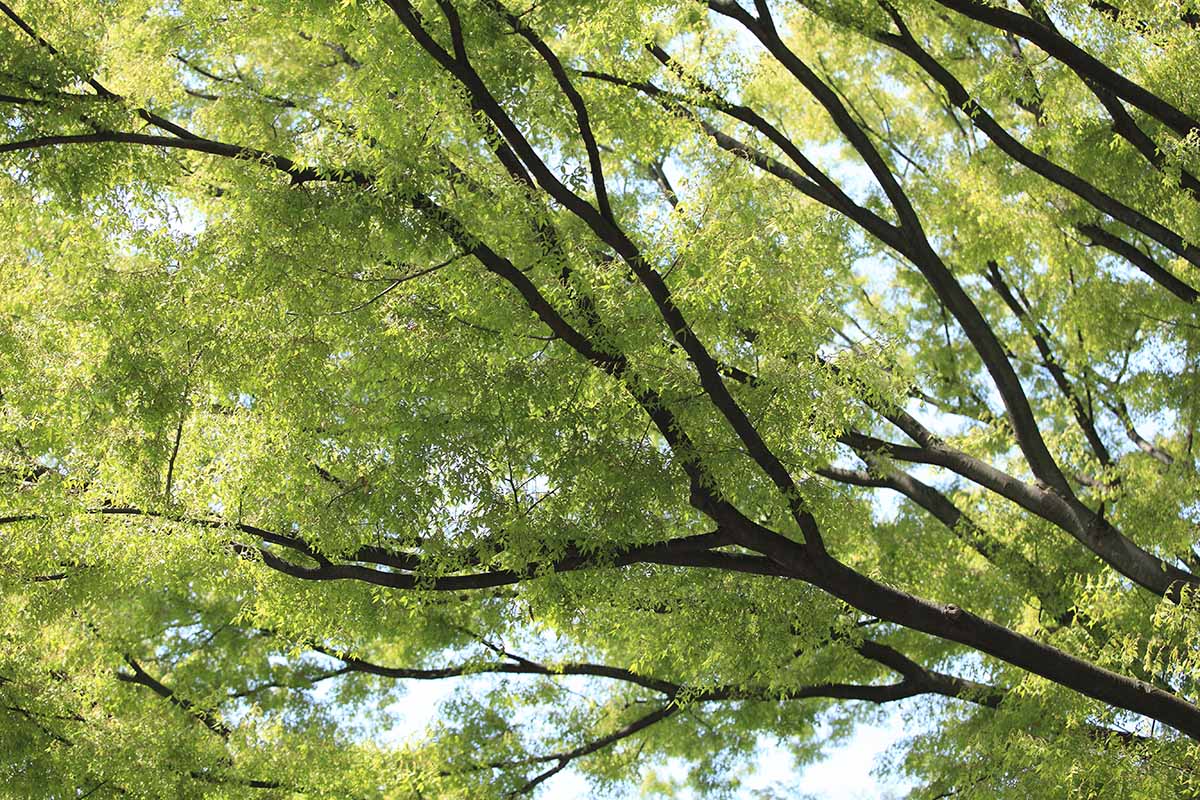
Got your seeds? Fill a gallon-sized zipper bag with sharp sand, add the seeds, moisten the media, seal the bag, and then place the bag in the refrigerator for 60 days.
Periodically check the media to ensure that it remains moist throughout this stratification period.
Once the 60 days are up – hopefully you labeled the bag with the start date! – fill three-inch containers with a 50:50 mix of peat moss and perlite.
Sow the seeds a quarter-inch deep, moisten the media, and then place the tray in indirect sunlight indoors, keeping the media moist all the while.
Once the seedlings develop two or three pairs of true leaves they’re ready for hardening off outdoors, provided there’s no risk of frost.
To do so, bring the containers outside into full sun for 30 to 60 minutes before bringing them back indoors.
Add an additional half to full hour of exposure with each passing day, until the seedlings are able to handle a full day outdoors.

Continue to care for your containerized Japanese zelkovas outside for a period of about two to three years by keeping their growing media moist and repotting as needed – a new container should be one to two inches wider than the root system, and deep enough to prevent constrained roots.
In winter, protection via tree wrappings or a stay in the greenhouse can help increase your sapling’s chances of survival.
At this point, your baby Z. serrata should be ready to transplant into the ground!
Via Cuttings
To begin, you’ll need an established Japanese zelkova tree to take cuttings from.
In spring or early summer, take a four- to six-inch cutting from the end of a new branch with a sharp and sterilized blade.
Defoliate the bottom half of the cutting before dipping the end into rooting hormone, such as this IBA rooting powder from Bontone that’s available from Arbico Organics.
Bonide Bontone II Rooting Powder
Fill individual three-inch containers with a 50:50 mix of peat moss and perlite. Stick each cutting into its own container, cut-end-first, and moisten the media.
Expose the cuttings to indirect light indoors, keeping the cuttings moist all the while.
The same rules apply as above – repot as needed, and always ensure that the container is adequately deep and provides the root system with an inch or two of elbow room.

The following spring, after the last frost, you’re good to harden off the cuttings with the same protocol that you might have used for seedlings.
Once you’ve done that, continue to care for the cuttings outdoors in containers for an additional year or two, making sure to repot and provide winter protection as needed.
After that, you have the green light to transplant!
Via Transplanting
These plants have a long taproot that can make transplanting tricky. To avoid taproot troubles, you should always opt to transplant a sapling over a more established specimen.

In spring, prepare deep and well-draining transplanting sites. Make sure they receive full sun exposure, and ensure that the soil has a pH of 6.0 to 7.5.
Spacing-wise, you have a few options. To give each tree ample amounts of elbow room, space the sites about as far as you expect your Z. serrata to spread at maturity, at least 50 to 80 feet apart.
For a line of closely neighboring Japanese zelkovas, space them about 30 feet apart.
Is it go time yet? Dig holes a little wider than and about the depth of the transplant’s root systems.
Gently ease your specimens from their containers or burlap, then lower them into the holes, making sure to leave the root flare exposed above the soil line. Backfill with soil, and water in.
After transplanting, maintain soil moisture.
How to Grow Japanese Kelkova Trees
Once your trees are in the ground and established, you’ll have to do your part to keep them alive and well.
Climate and Exposure Needs
As mentioned earlier, these plants need to be grown in USDA Zones 5 to 8. You should also provide full sun exposure – you wouldn’t want the plant’s shade-providing powers to go to waste!
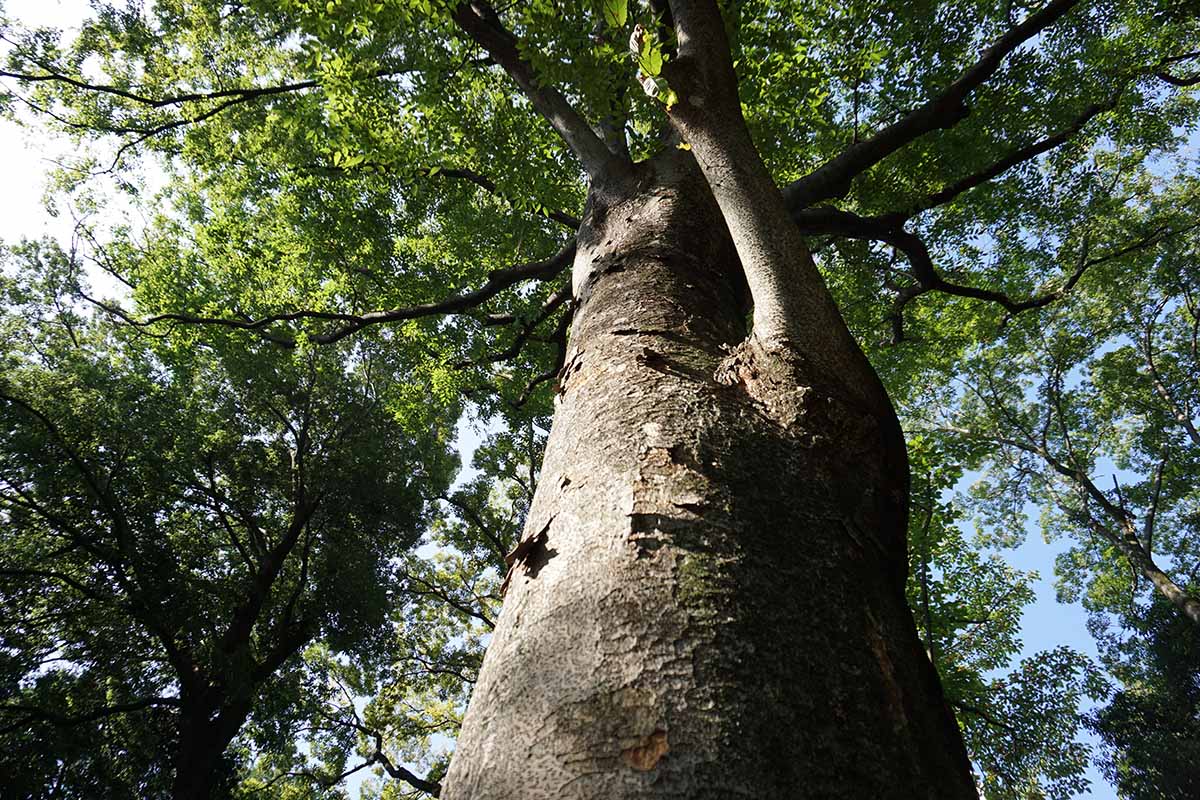
Japanese zelkovas are resistant to wind and air pollution, so they’re more than capable of thriving in wide open or urban spaces!
Soil Needs
The optimal soil for Z. serrata should be loamy with moderate fertility and a pH of 6.0 to 7.5.
It needs to drain excess moisture freely, and it must be deep enough for the tree’s taproot, which grows to be about as long as the tree is tall!
But the Japanese zelkova is more than capable of tolerating soil compaction, acidic and alkaline pH levels a bit beyond the recommended range, and a variety of soil textures.
It takes more than a suboptimal soil to stop these bad boys!
Irrigation and Fertilizer Needs
Although these trees can handle drought, they still grow their best in moist soils.
You can either situate these trees in naturally moist sites from the get-go, or provide deep irrigation whenever the top two to three inches of soil feel dry to the touch.
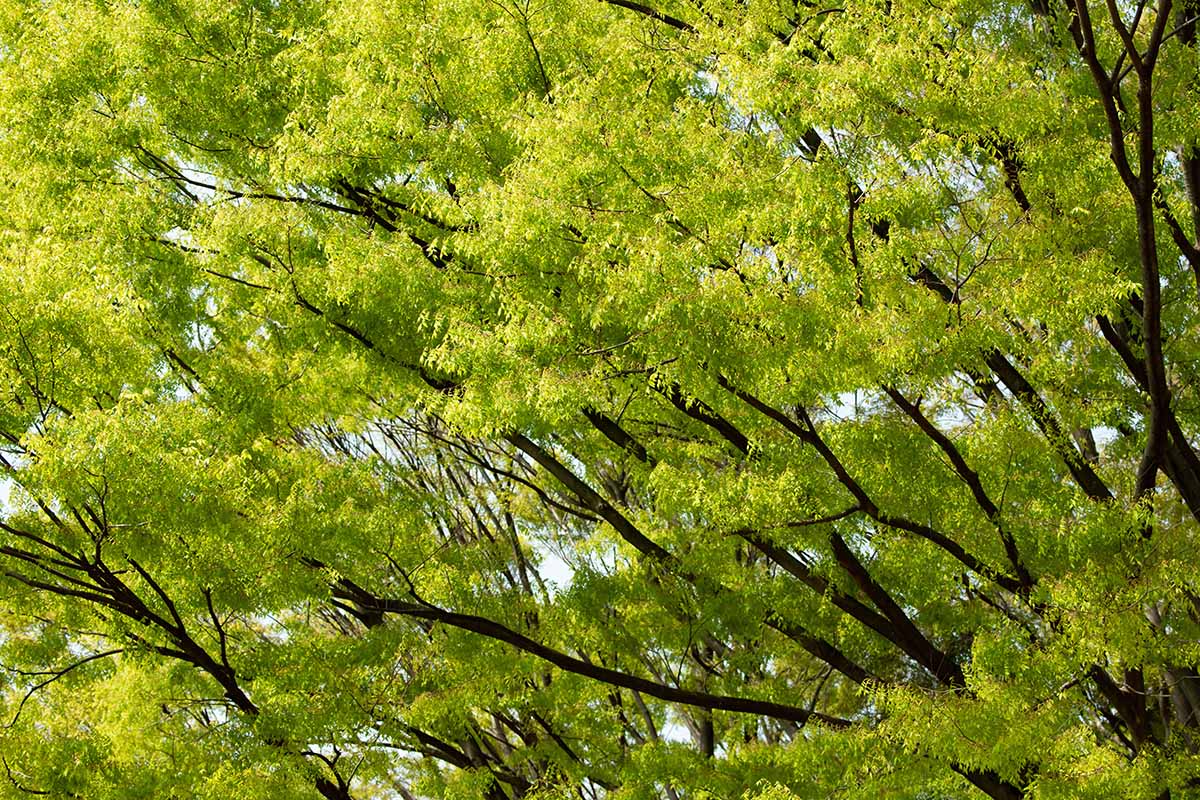
As for fertilizer? Z. serrata doesn’t need any supplemental feeding, so long as it isn’t planted in barren soil.
To prevent soil leanness, working an inch or two of compost or well-rotted manure into the soil each spring will help with friability as well as fertility.
Growing Tips
- Ensure that your trees receive full sun.
- Deep, loamy, and well-draining soils are optimal.
- Water whenever the top two to three inches of soil feel dry.
Pruning and Maintenance
A Japanese zelkova is absolutely gorgeous, but it does require some upkeep to maintain its aesthetic.
After the tree drops seeds, any unwanted seedlings should be pulled if they happen to sprout.
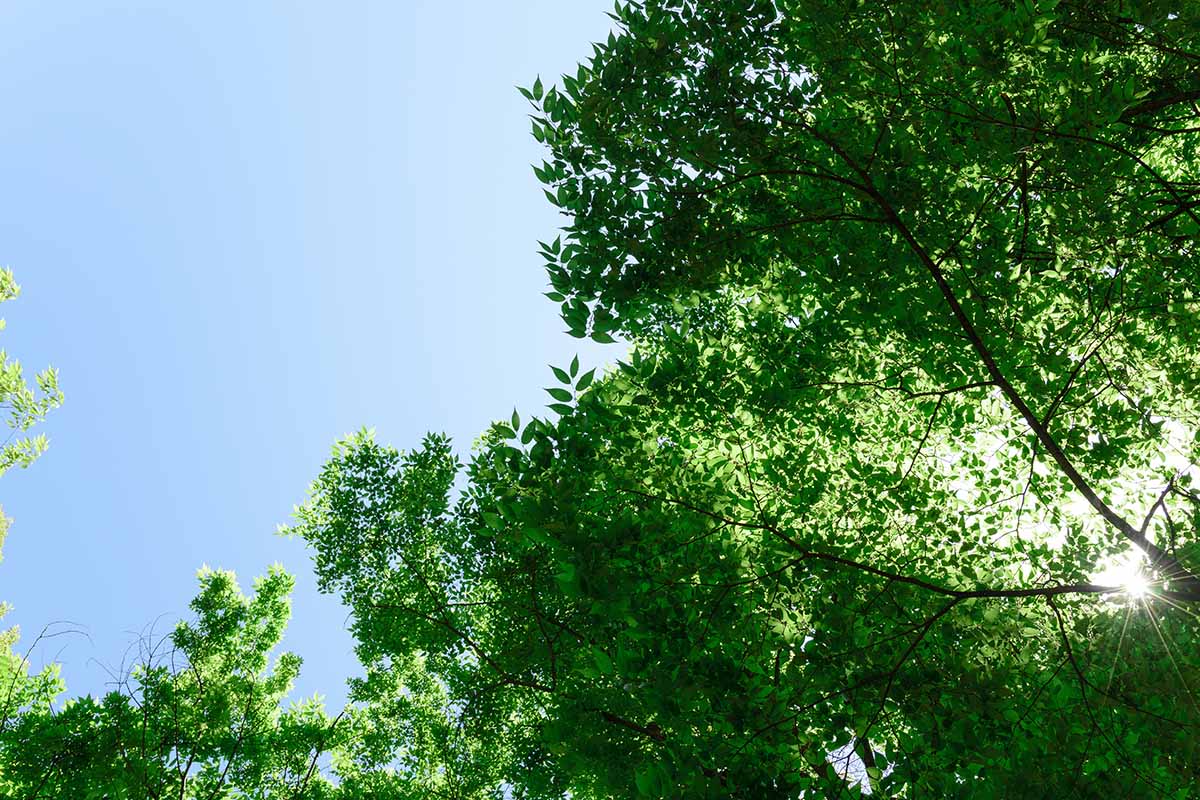
Dead, diseased, and damaged branches should be pruned whenever you happen to notice them, while a more dedicated session of pruning can take place in spring, after the first frost.
If a more thorough pruning session is necessary to emphasize the tree’s strong and upward-branching structure, removing any weak or downward-angled branches, this may require the help of an arborist for taller specimens.
As with most types of pruning, don’t remove more than a third of the tree’s aboveground mass in one go.

Adding mulch is a great way to protect the roots, conserve soil heat and moisture, and even add some flair to what might otherwise just be bland soil.
In mid-spring, add two to three inches of mulch in a ring around the trunk, making sure to keep the ring at least a couple inches away from the trunk and root flare.
Some time after Z. serrata leaves flaunt their beautiful fall colors, they’ll drop. You may want to rake them up at this point, especially if they’ve fallen onto turf.
Japanese Kelkova Cultivars to Select
As any fan of Weird Al knows, new twists on old favorites make for good times. Here are some Z. serrata cultivars that bring some exciting new features to the metaphorical table.
Green Vase
If you’re interested in planting a line of Japanese zelkovas, ‘Green Vase’ will get the job done right.
This variety is a lot narrower than the standard species – ‘Green Vase’ typically reaches a height of 60 to 70 feet, with a spread of 40 to 50 feet.
This reduced span makes ‘Green Vase’ perfect for planting close to each other, or if you really want to emphasize height over spread.
In its youth, this cultivar grows much quicker than a standard Japanese zelkova. To top it off, it’s also quite winter hardy with improved resistance to harsh conditions!
For those interested in two- to seven-foot ‘Green Vase’ transplants, head on over to FastGrowingTrees.com.
Halka
With a mature height and spread of 50 by 30 feet, ‘Halka’ is the clear choice for those who want fast juvenile growth and yellow fall color.
Musashino
Can’t decide between ‘Green Vase’ and ‘Halka?’ Split the difference with ‘Musashino,’ a cultivar that combines a narrow spread with yellow autumn hues.
With a height of 45 feet and spread of 15 to 20 feet, it’s even more slender than ‘Green Vase.’
Village Green
For those who like their Z. serrata wide, you’d be well-served with ‘Village Green.’
It’s even wider than the standard species, reaching 40 feet in both height and spread. Add dark red autumnal colors and solid winter hardiness to the mix, and you’ve got yourself a real winner.
Managing Pests and Disease
A Japanese zelkova is pretty tough, with notable resistance to Dutch elm disease and elm leaf beetles. But it’s not invincible, so let’s take a look at some of the chinks in its armor.
Insects
Along with the damage that they cause, insects can act as carriers for pathogens. By dialing in your pest management, you’ll also be lowering the odds of infection.
Calico Scale
Also known as Eulecanium cerasorum, calico scale is a kind of soft scale that afflicts many different species of shade and flowering trees.
Adult calico scale insects are hemispherical in shape, a quarter-inch wide, and black with white spots, while juvenile E. cerasorum are smaller and yellow-bodied.
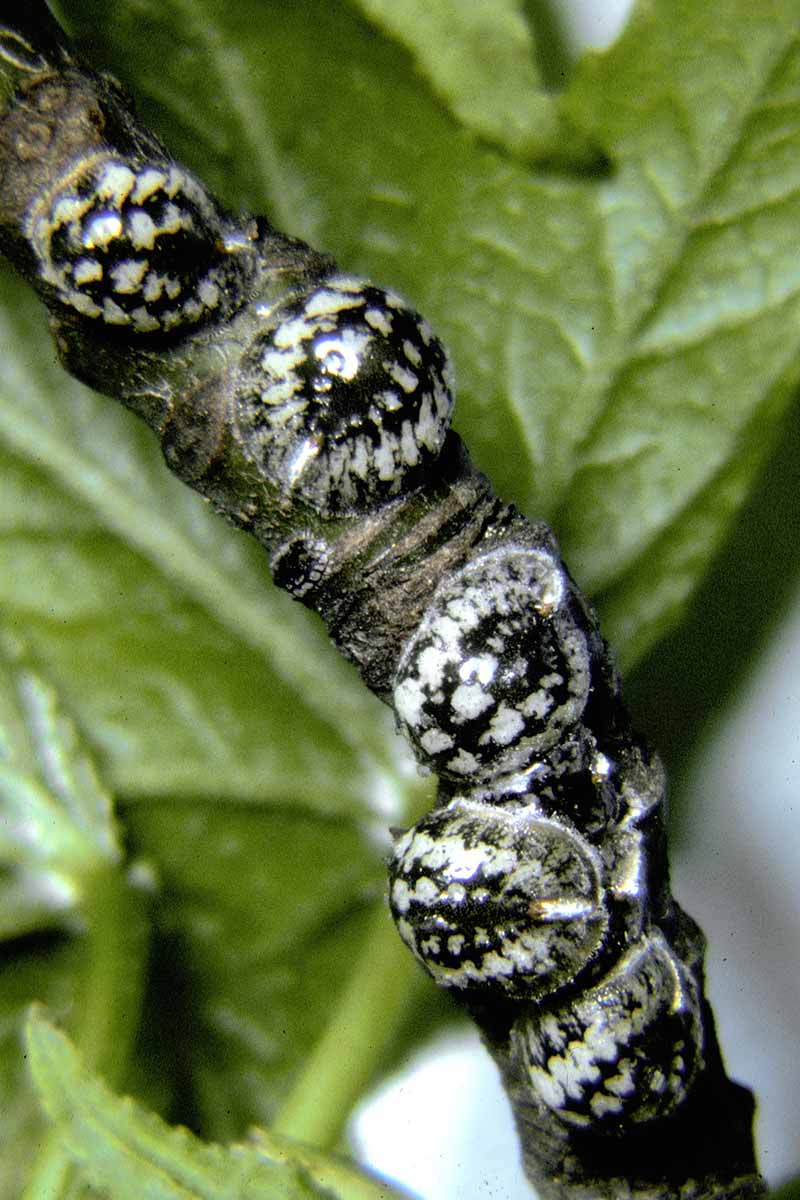
In spring, the adult females turn brown and die before the eggs within their bodies hatch.
Come summertime, the hatched juveniles will feed along leaf veins before overwintering in the bark later in the season.
When they emerge as adults, they feed on sap from stems.
This can lead to chlorosis, stunted growth, defoliation, branch dieback, and even plant death. Adult calico scale also excrete honeydew, which can attract ants and lead to black sooty mold.
Aside from proper plant cultivation, calico scale can be controlled with natural enemies such as ladybugs and parasitic wasps, which can be purchased from Arbico Organics.

Sprays of horticultural oil during the dormant season can also be effective. For a quart of ready-to-spray horticultural oil from Bonide, head on over to Amazon.
In the case of heavily-infested branches, your best bet is pruning the entire branch.
Leafrollers
“Leafrollers” are the caterpillars of Tortrix moths – moths from the Tortricidae family – named for their tendency to web up tender leaves into a rolled shape with their silken threads.
Leafrollers feed within the leaf, which results in foliar chewing damage. Large infestations can even lead to defoliation, though this won’t usually kill an established tree.
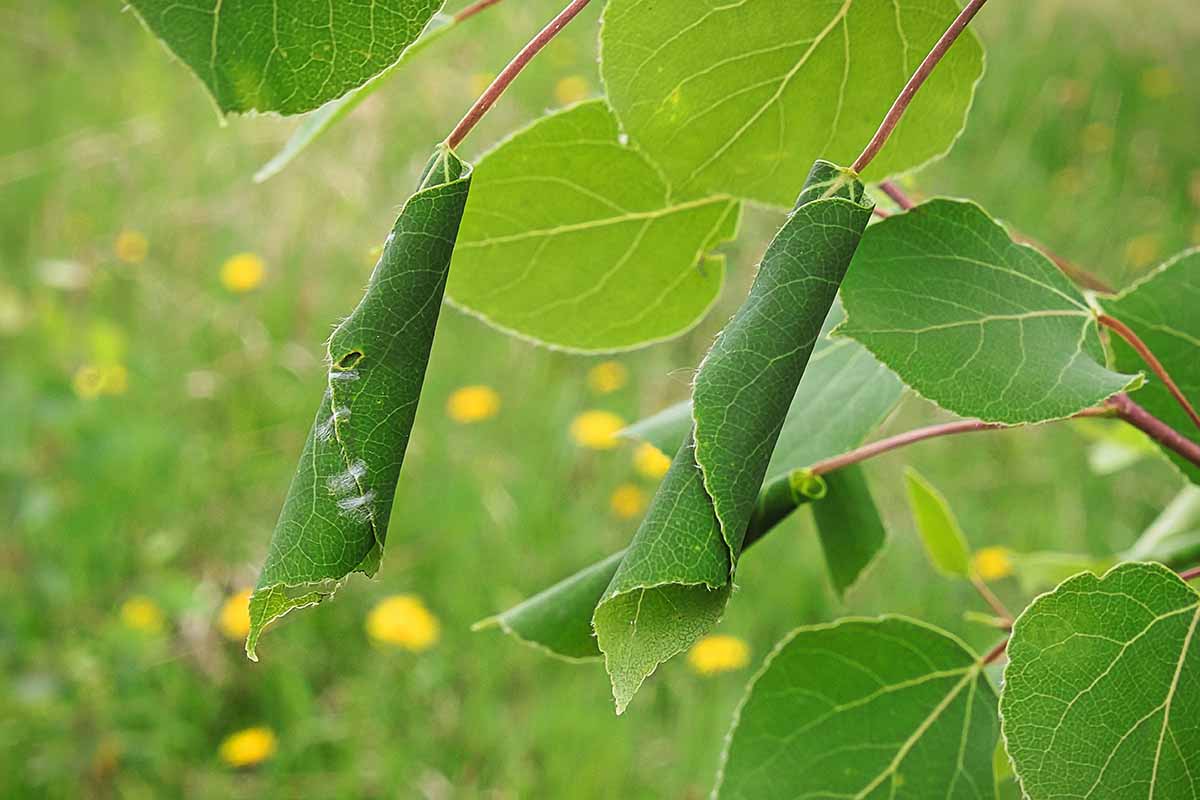
By hiding in the leaf, leafrollers are protected from predators and insecticides, which can make control a bit of a challenge.
Sprays of insecticidal soap during winter dormancy can help to control the eggs, while applications of Bacillus thuringiensis in spring work against the larval stage.

If you go with the Bt, you should apply it as soon as or immediately after the larvae hatch. For a primo product, try this 32-ounce spray bottle of Bt from Bonide that’s available on Amazon.
For additional biological control, a variety of metal-sounding insects will munch on leafrollers, from parasitic wasps to assassin bugs. To peruse some options, check out Arbico Organics.
Spider Mites
These arachnids can be hard to spot with the naked eye… Although if you took a hand lens to an infestation, you would notice tiny, oval-bodied, and bristled pests.
Spider mites use their piercing-sucking mouthparts to extract essential plant juices from foliage, which leaves noticeable symptoms behind.
Along with webs and small puncture wounds, infested leaves may exhibit chlorosis and faded green hues.
Hot and dry summers can increase the odds of a spider mite attack in Japanese zelkovas.
Even though they can handle some drought, it’s imperative to keep your specimens well-watered when conditions are hot and dry to prevent spider mite infestation.
If an infestation has already occurred, powerful sprays of water can blast spider mites off of leaves.
Beneficial mites can act as predators of spider mites, and sprays of horticultural oils or insecticidal soaps can help with control as well.
Learn more about spider mites and how to control them in our guide.
Disease
The risk of infection can be greatly reduced simply by being sanitary. This means sanitizing your gardening tools, using soils that are free of disease, and purchasing pathogen-free plants.
Bacterial Canker
Caused by Pseudomonas syringae in wet, cool conditions, bacterial canker can leave the otherwise beautiful bark of Z. serrata looking sickly, unaesthetic, and just plain gross.
Along with the sunken, discolored, and oozing cankers, flowers can wilt, leaves can develop holes or fall off entirely, and branches can die back. In time, the entire tree can perish.
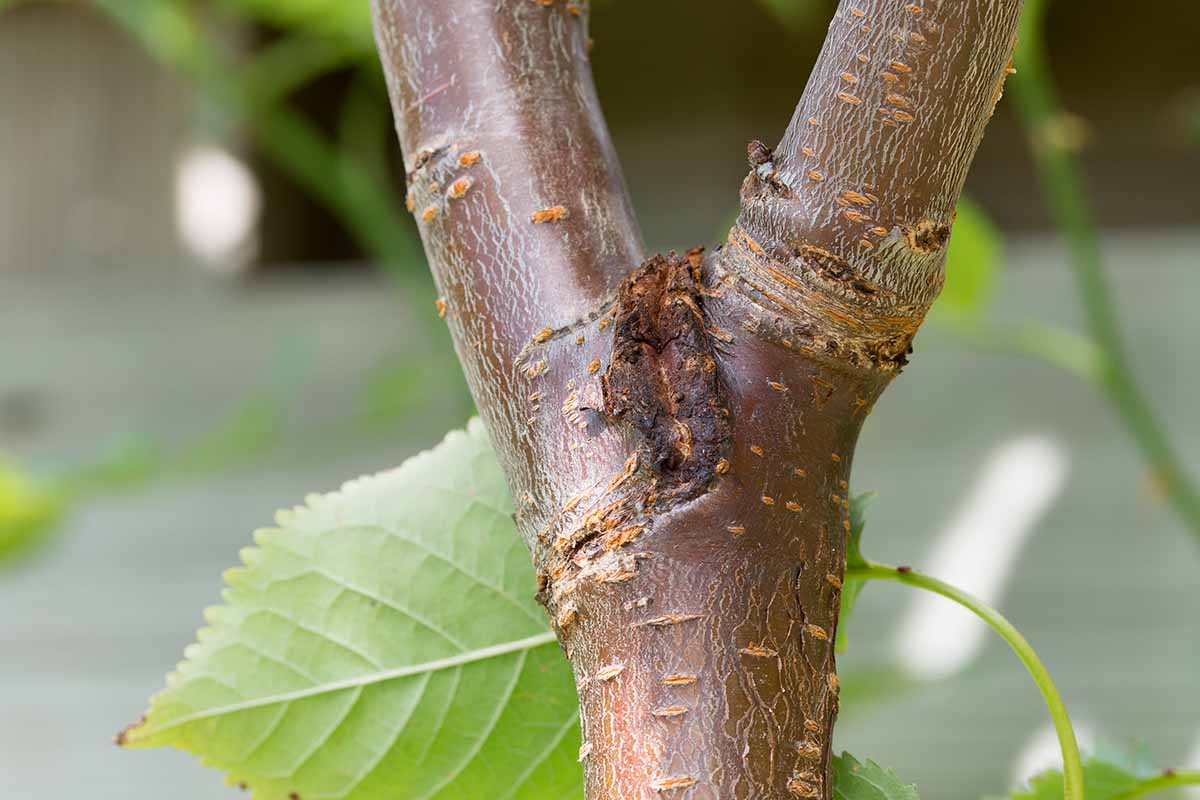
Overwintering in preexisting cankers, asymptomatic branches, and unopened buds, the bacteria can be spread via wind, water, bugs, and contaminated pruning tools.
Prevention offers your best shot at keeping your trees healthy – remove nearby weeds that can serve as potential overwintering sites, don’t overwater your trees, and be sure to prune properly.
That last tip is especially important – it eliminates potential overwintering sites, and removes vulnerable structures that the bacteria could enter.
Elm Yellows
A serious disease of Ulmaceae plants, elm yellows is caused by pathogens in the phytoplasma group Candidatus Phytoplasma ulmi, a gang of microparasites that spread and multiply within a plant’s phloem to wreak havoc.
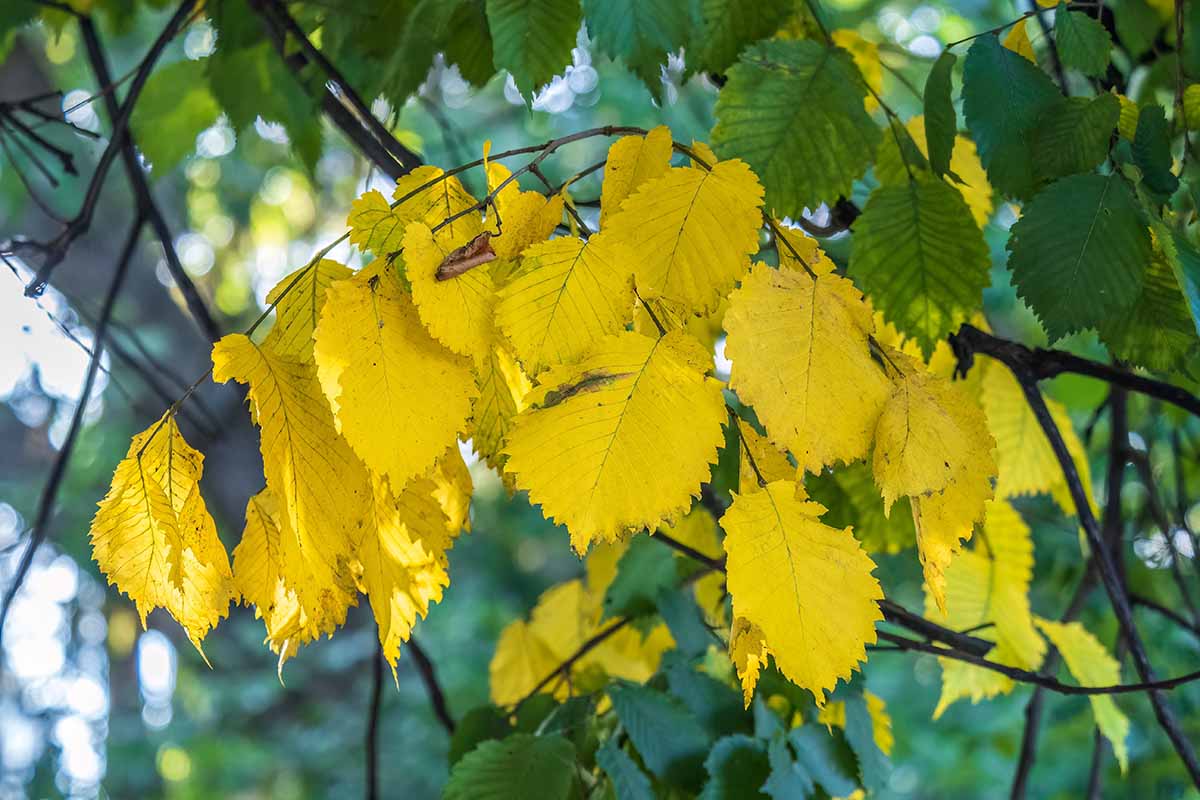
These pathogens are spread by insects such as leafhoppers and spittlebugs, and are acquired and transmitted as insect carriers feed on infected shoots, followed by healthy ones.
Symptoms manifest as yellowing leaves, drooping petioles, and premature leaf drop. In some cases, infected trees can quickly wilt and perish without warning.
Besides keeping up with your pest management, there isn’t a known cure or prevention tactic available for elm yellows.
Infected trees should be removed and replaced with non-elm relatives, or perhaps a resistant elm species such as Ulmus glabra.
But resistance doesn’t equal immunity, so proceed with caution if you know that you’ve got an infection on your hands.
Best Uses for Japanese Kelkova Trees
By putting a Japanese zelkova where it looks best, a green thumb can really dial their Z. serrata game up to 11.
With its beautiful, densely-growing foliage, you can block out harsh rays in style.
Even on cloudy days, these trees stand out as gorgeous specimen plantings, whether they’re situated on a lawn or on a street corner.
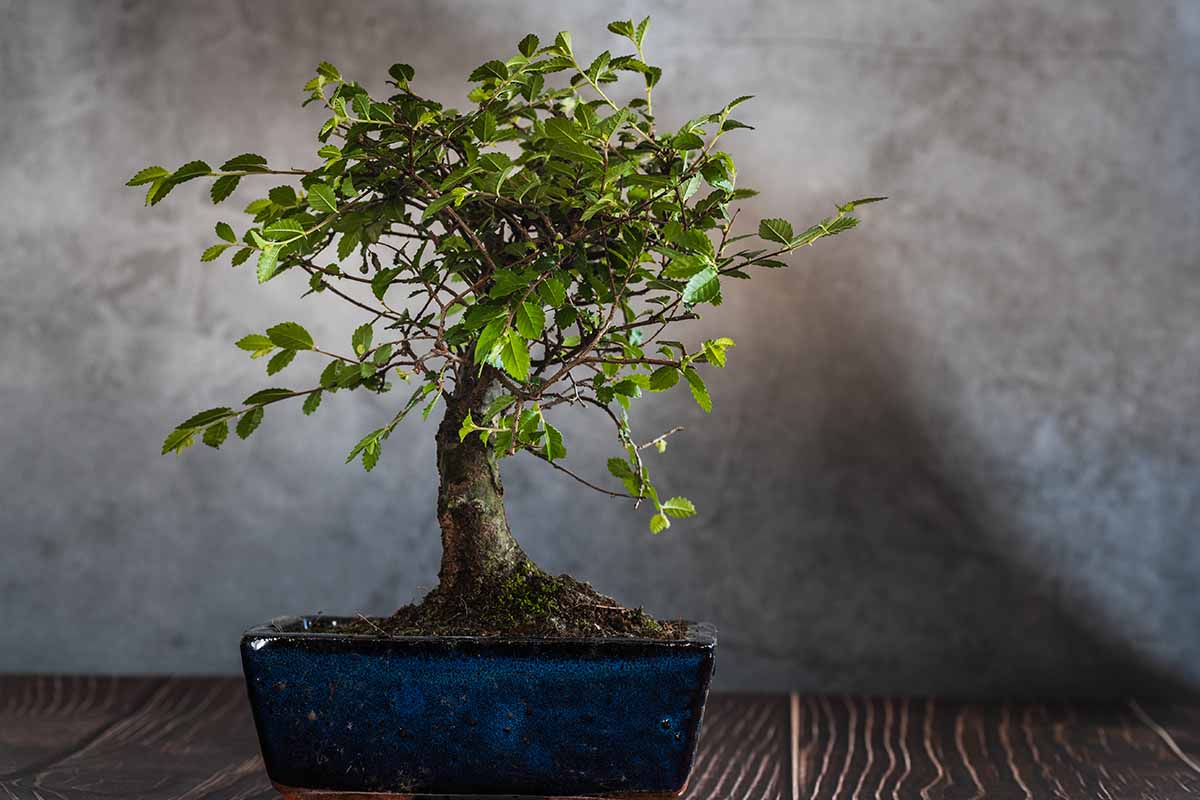
The lush green leaves, stunning fall hues, and visually striking bark combine to make this tree a multi-season beaut.
For the horticultural wizards among us, Z. serrata can even be grown as bonsai!
Quick Reference Growing Guide
| Plant Type: | Deciduous tree | Flower/Foliage Color: | Green (inconspicuous)/green |
| Native to: | China, Japan, North and South Korea, Russia, Taiwan | Water Needs: | Moderate |
| Hardiness (USDA Zones): | 5-8 | Maintenance: | Low |
| Bloom Time: | March to April/spring | Tolerance: | Air pollution, drought, Dutch elm disease, elm leaf beetles, various soils, wind |
| Exposure: | Full sun | Soil Type: | Moist, deep, loamy |
| Time to Maturity: | 5 years | Soil pH: | 6.0-7.5 |
| Spacing: | 30 feet | Soil Drainage: | Well-draining |
| Planting Depth: | 1/4 inch (seeds), depth of root system (transplants) | Uses: | Bonsai, landscaping, shade tree, specimen planting, urban planting |
| Height: | 50-80 feet | Order: | Rosales |
| Spread: | 50-75 feet | Family: | Ulmaceae |
| Growth Rate: | Moderate to fast | Genus: | Zelkova |
| Common Pests and Diseases: | Calico scale, leafrollers, spider mites; bacterial canker, elm yellows | Species: | Serrata |
I Foresee You Loving This Tree
I lack the gift of prophecy, but I believe this is a pretty safe bet.
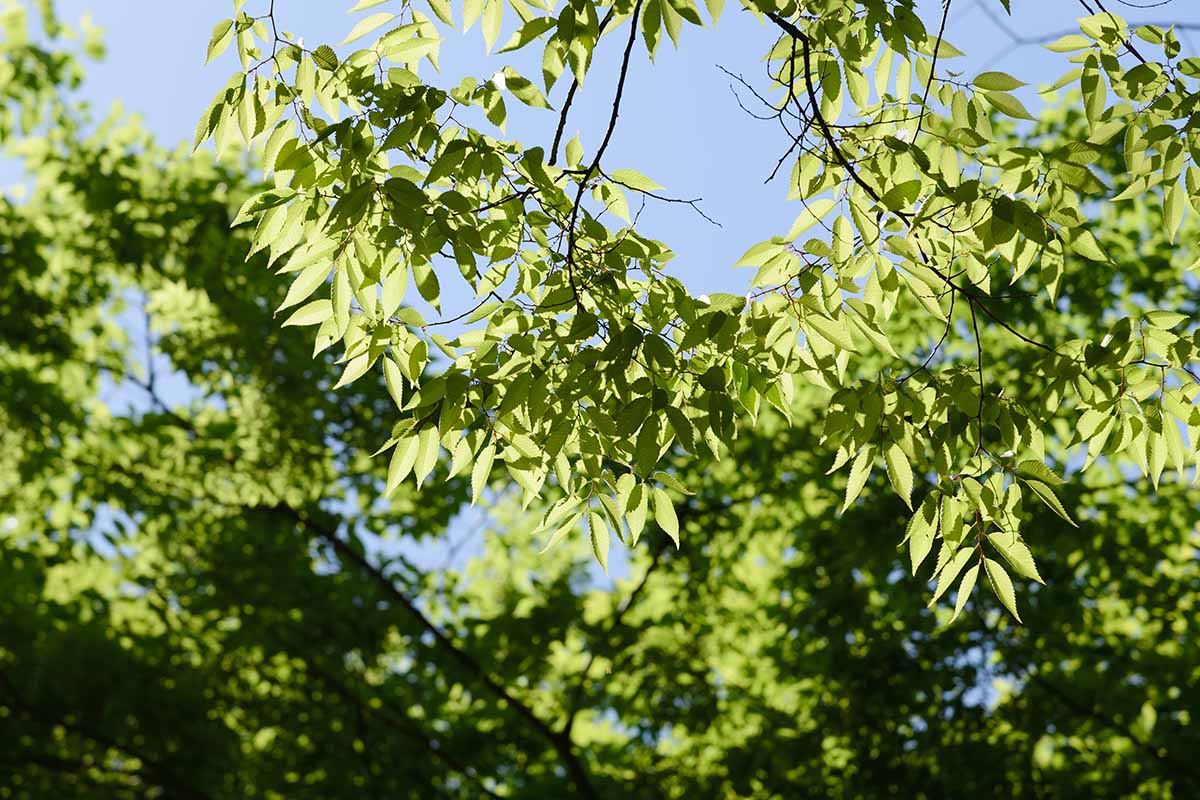
Now that you know how to grow a Japanese zelkova, there’s nothing stopping you from cultivating a landscape filled with beautiful trees… Other than time and effort, I suppose. Anyway, go forth and grow!
Have any unanswered questions or unshared remarks? Head on down into the comments section below.
Looking for other landscape trees to shield you from the sun? Check out what we’ve got in the queue:
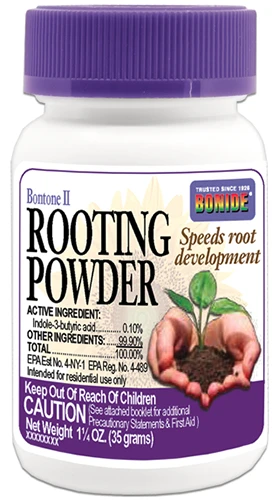
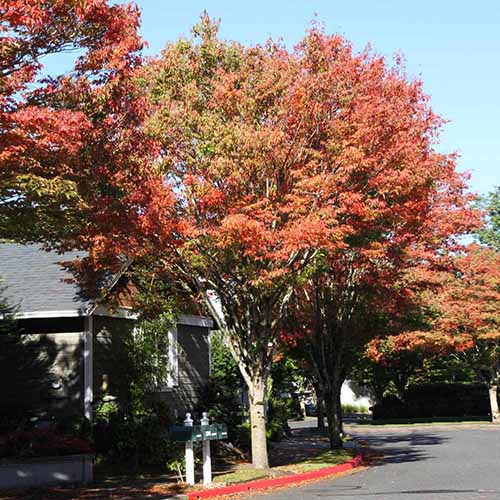
I have read that aphids can be a problem but you don’t mention them; also damage from winter ice can occur to the Green Vase version. I am in zone 6.
Hey, Mary! Yes, aphids can be a problem – they can use their piercing-sucking mouthparts to extract vital fluids from plant leaves and stems, and they can also excrete honeydew, which attracts ants and leads to black sooty mold. Strong sprays of water can blast them off plant surfaces, while applications of insecticidal soap or horticultural oil will kill them outright. If your zelkova is at risk of winter damage, then you can insulate the roots with mulch and wrap the trunk with white commercial tree wrap or a plastic guard. Zone 6 is within a Z. serrata‘s hardiness range,… Read more »